How to Choose the Best Aluminum Greenhouse

This post follows our research editorial guidelines.

While you may typically think of a wooden frame when it comes to traditional greenhouses, aluminum alternatives are becoming exceedingly popular as they are lightweight, rust-proof, cheaper, and easier to assemble. You also do not have to worry about the greenhouse frame rotting from years of rain or snow. Therefore, an aluminum greenhouse is often the number one choice for successful greenhouse gardening.
Yes, there will always be proponents of the rustic natural look of a wooden greenhouse, but the practical advantages of aluminum often outweigh the looks. So, what caused this meteoric rise of aluminum as the best greenhouse frame material, and should you benefit from one in your garden?
Read on as I discuss everything you need to know to make an informed decision if and when you buy an aluminum greenhouse.
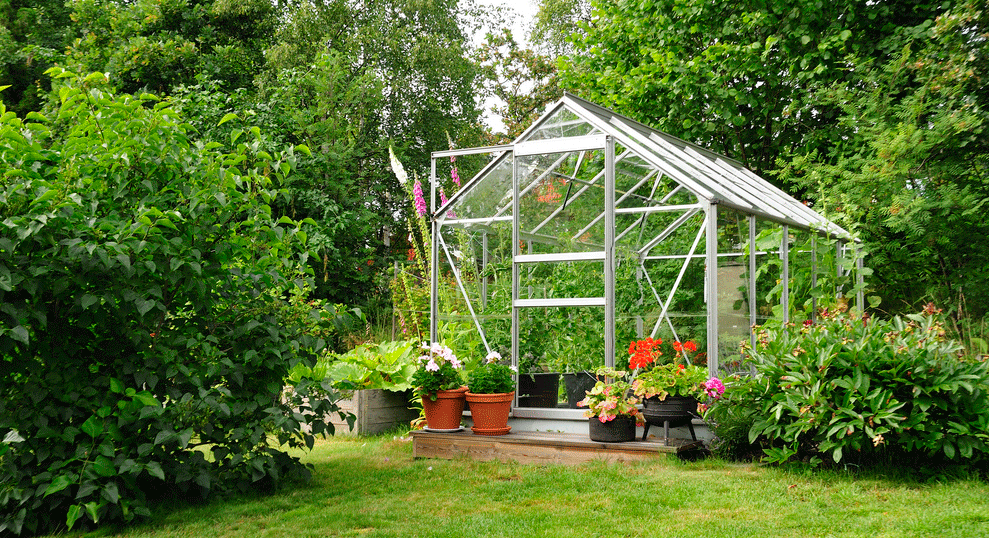
Attention Garden Lovers: This post contains handpicked links to recommended gardening products. If you buy something through these links, I may earn a small commission at no extra cost to you.
Table of Contents
What is an Aluminum Greenhouse?
Aluminum greenhouses are basically greenhouses that have aluminum frames. In recent times, aluminum frames have become the standard greenhouse holding structure because of the material’s resistance to natural elements.
These greenhouses can withstand rain, snow, sunlight, and pretty much all harsh weather conditions without rusting, making them highly durable and long-lasting. These characteristics are precisely what you want in a greenhouse intended for housing potted plants, extending the growing season, sowing seeds, and nurturing young plants as they prepare for transplantation. Heck, you can even use greenhouse heaters and try your hand at growing tropical plants in a colder climate! If your structure is sturdy and long-lasting, the possibilities to up your gardening game are endless, which is what aluminum provides.
Since resistance to natural elements is often the most significant consideration when choosing materials for any outdoor framework, Aluminum greenhouses have established themselves as the style to beat when compared to wooden greenhouses. In addition, the structure has various greenhouse glazing panels, which dictate light transmittance and temperature management (more on this later in the article).
Because aluminum greenhouse frames are the most common structures, you will have a lot of choices regarding shapes, sizes, and colors. You can find aluminum frames for everything from a mini greenhouse to a lean-to greenhouse to a massive freestanding greenhouse. Moreover, you can find the frames in different colors with a powder-coated finish to aesthetically fit into your garden.
In addition, aluminum frame greenhouses are easy to assemble and almost maintenance-free.
The Benefits of an Aluminum Greenhouse Vs. A Wooden Greenhouse
I have already talked about how Aluminum frames are a better choice than wooden alternatives since they are easier to install and way cheaper. But, the steep price tag of the wooden kits is not the only reason to choose a greenhouse with aluminum frames. There are various other solid benefits that aluminums frame modern greenhouses present, which wooden ones cannot. Let’s hatch them out in detail below.
Longevity
The most significant benefit of opting for an aluminum greenhouse is its longevity. While frame material, whether aluminum, wood, steel, or plastic, will deteriorate over time, aluminum’s lifespan well surpasses all its counterparts. Aluminum is essentially rust-proof, which means it will withstand the test of time. In contrast, wooden structures would rot or need careful selection (while you spend big bucks) to find the kind with enough endurance against natural elements.
Especially when buying larger greenhouses, the intention is to go for a material that will last a long time, and aluminum is perfect for that.
Durability
Wooden greenhouses are often more robust than aluminum ones, which may not fare well against a rain storm. Yet, an aluminum kit with a higher-strength rating can not only provide sturdiness, but its durability against natural elements also makes it a no-brainer choice in comparison.
Moreover, aluminum requires minimum maintenance. Suppose the powder coat comes off; the original silver surface is still rust-proof and will last you many years, albeit being much less aesthetically pleasing.
Lightweight
Wooden greenhouses are made for heavy beams that require a lot of muscle to put together into an actual functioning greenhouse. Aluminum, on the other hand, not so much! The lightweight material is much easier to assemble and can even be moved if the need arises.
The heavy wooden beams have more weight which provides better support, yes, but their width also casts shade on the panels, often restricting the maximum amount of sunlight coming through the greenhouse roof and sides. It can be an even bigger issue if the greenhouse is placed next to other garden buildings that cast additional shadows.
In comparison, aluminum rods are much narrower, allowing the most light into your growing space.
More Design Options
Since aluminum is the most famous structure material for greenhouses, it is naturally available in most design options. The aluminum is much more pliable than steel or wood; thus, you can find it in various sizes and colors. From small lean-to greenhouses to huge freestanding greenhouse designs, you can definitely find something that fits your taste and space to grow plants.
What are the Panels Used in Aluminum Greenhouses?

Greenhouse glazing is made from various materials with different price points, light transmission, and heat retention. There are several other materials to choose from, from horticultural glass to toughened glass to plastic. However, when it comes to aluminum structures, you will often find them combined with polycarbonate panels.
Polycarbonate greenhouses are much safer and more cost-effective than their glass counterparts unless you use salvaged glass. However, choose good quality twin-wall polycarbonate panels to provide the needed insulation. Moreover, polycarbonate greenhouses are low maintenance with no need for regular cleaning like glass panels.
“Aluminum is relatively strong, rigid, and lightweight the material is resistant to U.V. degradation and experience little reduction in light transmittance for 10 years.”
Dr. Michael R. Evans of the Department of Horticulture at the University of Arkansas
When buying a polycarbonate greenhouse with an aluminum frame, you often choose between panel opacity, ranging from transparent to milky white, depending on how much light you want to allow through the roof and side panels.
Some aluminum greenhouse frames are also fitted with toughened safety glass, which provides much more protection and maximum light, but is way more expensive than their plastic counterpart. Therefore, you will rarely find toughened glass panels in a budget greenhouse.
One thing to note is that if not fitted correctly, polycarbonate panels can get cloudy with time, forcing a replacement from you.
Best Plastic Mini Greenhouse Kits
Palram Canopia 4×2 Lean-to Grow House
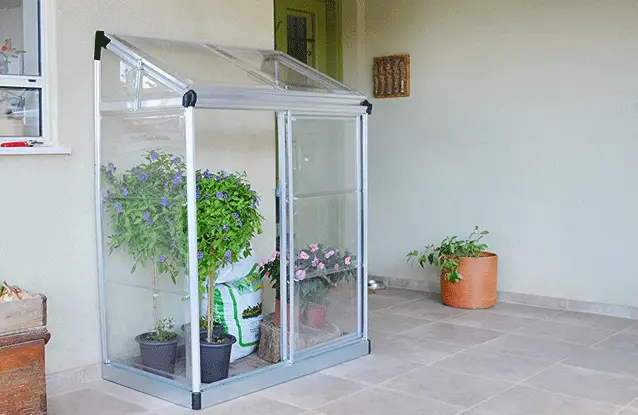
If you have a small space but want enough headroom to grow taller plants, this Palram lean-to greenhouse is perfect for you. Twin-walled polycarbonate panels protect against U.V. rays while letting 90% sunlight in for plants to thrive. The roof panels also double as a vent and open to allow air circulation. In addition, its sleek design contains a sliding door half the width of the entire unit, meaning you have plenty of room to reach your plants.
Even though this is a smaller unit, keep in mind that the assembly can be pretty tough with no clear instructions available. That said, this unit is the perfect size for a small garden and even a balcony.
Close Second: OGrow Aluminum Greenhouse for Outdoors
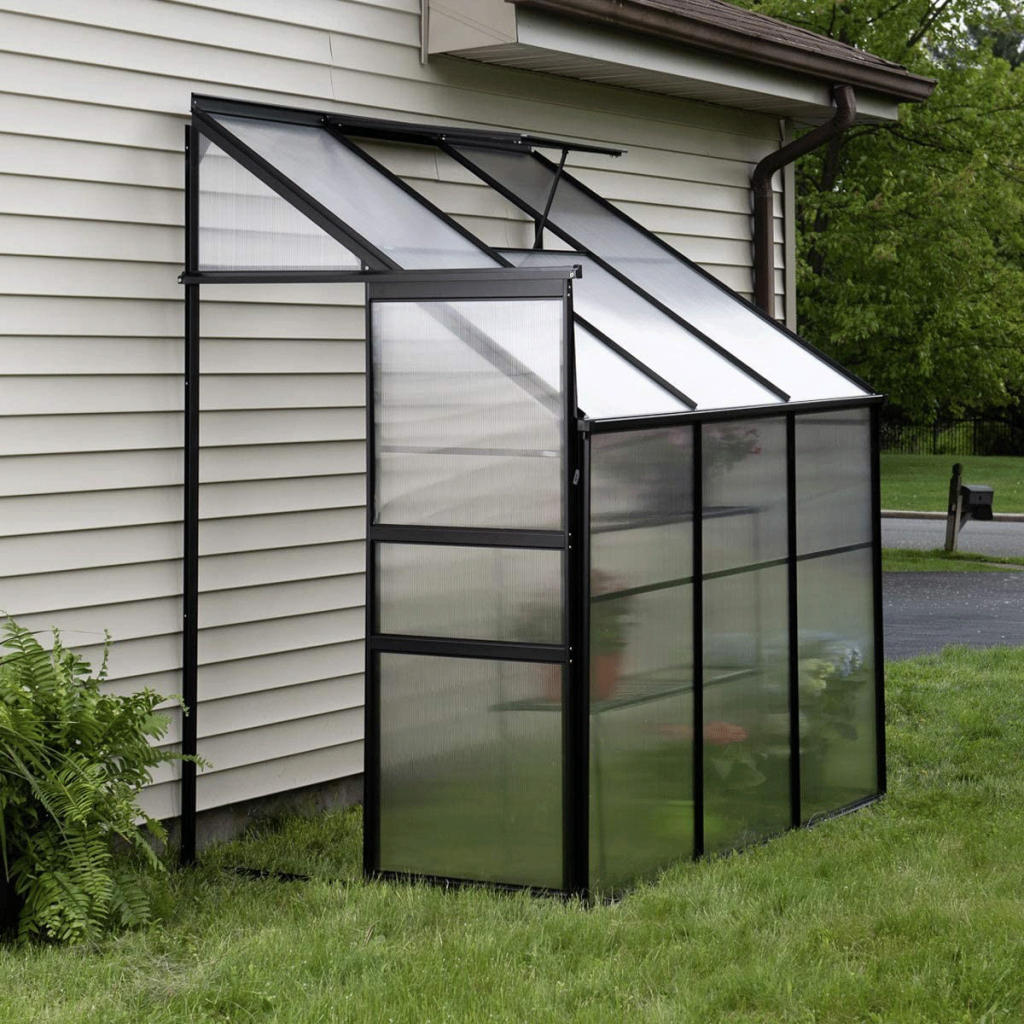
The OGrow lean-to greenhouse has an aluminum alloy framework with twin-wall polycarbonate panels that protect your plant from U.V. rays. The roof has a vent and gutter system that keeps natural elements out while allowing adequate air circulation and temperature control. The dark frame color makes the unit look way sleeker than your round-the-mill lean-to greenhouses.
But, here’s the catch: while the unit comes with an app to help users with the assembly process, many people still struggle to follow the steps. In addition, most people found the instructions incomplete, making the assembly of a comparatively small greenhouse harder than it needs to be.
Best Plastic Small Greenhouse Kits
Outsunny 6ft x 4ft Clear Polycarbonate Greenhouse
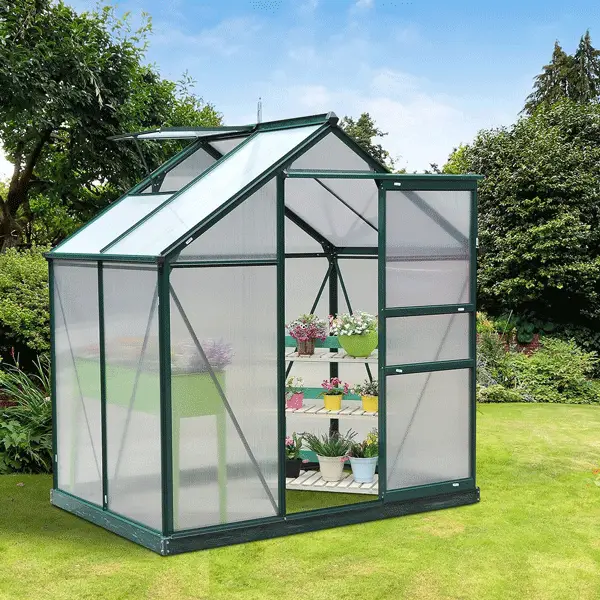
If a small hobby greenhouse is what you are looking for, then this Outsunny clear polycarbonate greenhouse is right on the money for you. This unit is as stable as they come with dual polycarbonate boards and slant support bars on all four sides. The roof vent provides adequate ventilation, whereas the ground bolts reinforce the base. The rain gutter on the roof collects rainwater and snow. However, the unit’s panels could have been sturdier. Users often resort to reinforcing them with duct tape to keep the greenhouse well-insulated.
Apart from that, one significant complaint about this greenhouse is that it is challenging to assemble, often requiring hours of back and forth while trying to piece it together. Don’t get me wrong, once it is standing, it is an excellent greenhouse, but hours of assembly can be overwhelming for a hobbyist.
Close Second: Palram – Canopia Hybrid Lean-to Greenhouse – 4′ x 8′
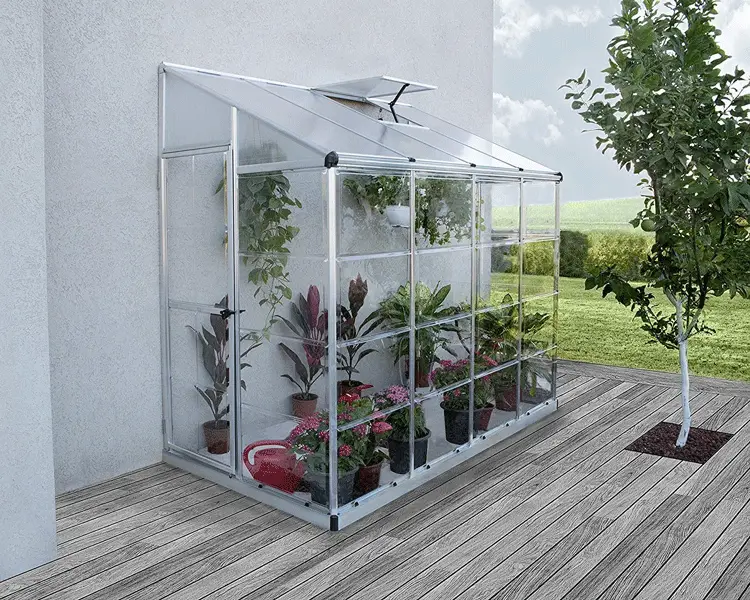
This 4×8 ft. lean-to is space-efficient while having all the features that one would expect from much bigger greenhouses. The aluminum frame and polycarbonate panels look good and make for a sturdy unit that can lean against a wall but still has ample space for climbing plants. The roof has in-built gutters as well as a vent for air circulation. It also has a lockable door with a magnetic catch. From UV protection to adequate light diffusion, this unit has it all.
While it’s definitely worth the effort, the assembly can be a killer, especially if it is your first time unpacking such a greenhouse. Unfortunately, it also does not come with a floor.
Best Plastic Large Greenhouse Kits
JULY’S SONG Upgraded 6’x8′ Hobby Greenhouse
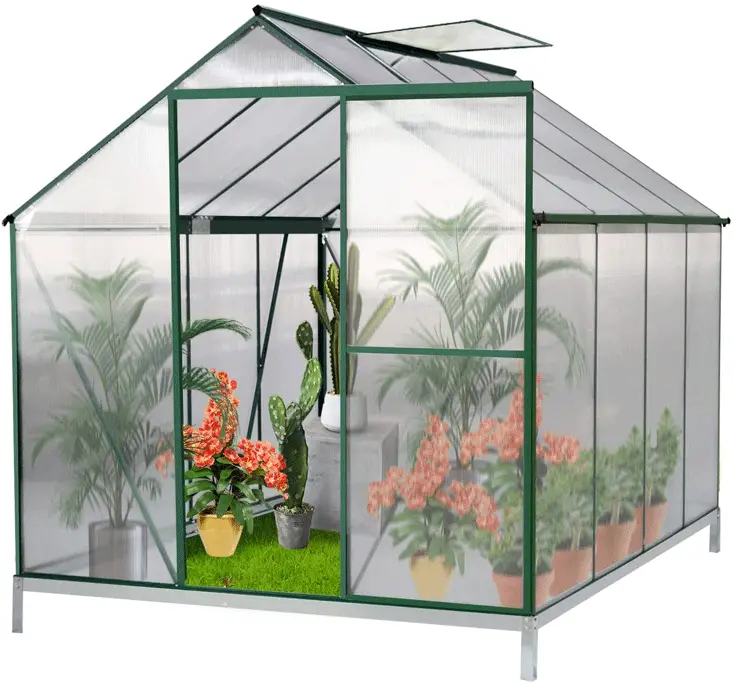
This large greenhouse from JULY’S SONG has a sleek powder-coated aluminum structure with a galvanized steel base. The base structure also comes with 8-inch long reinforcement posts that keep the greenhouse in place. This hobby greenhouse has everything from a sliding door to a rain gutter to a roof vent. There is ample headroom for you to take care of your plants while inside the greenhouse. The thing that I like the most about this unit is that it comes with a one-year warranty. So, if you get stuck somewhere during the assembly or have any faulty parts that need replacement, you can call customer service to do the needful.
However, as is usually the case with more extensive greenhouses, a lot of users find the assembly process difficult. In fact, I would not recommend doing this alone if you do not wish to spend hours putting it together. Although challenging, once up, the unit is worth the wait: a lovely greenhouse with good garden space.
Close Second: Palram 8ft x 8ft Glory Greenhouse
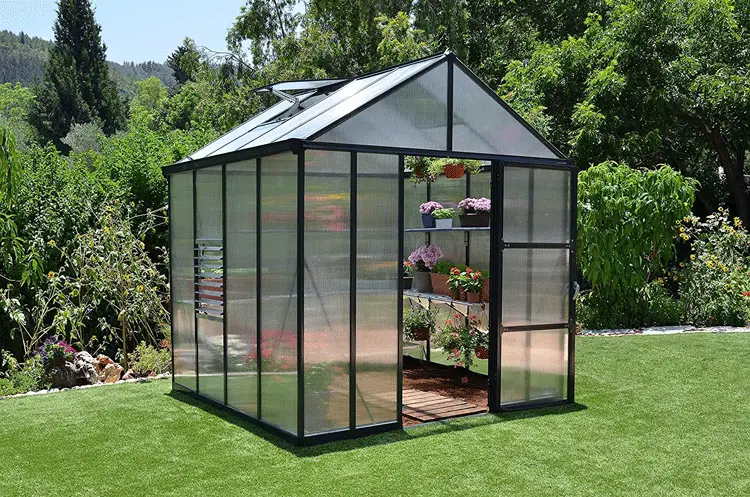
While the Palram mega-greenhouse is definitely superior in quality to my first pick for this category, I have only rendered this a runner-up because of the steep price tag. Unfortunately, not everyone can afford to pay almost $3000 for a greenhouse. That said, this 8 x 8 ft. unit has simple assembly instructions and provides excellent insulations thanks to 10mm thick dual polycarbonate panels.
This unit comes with a sturdy galvanized steel base. However, this unit has no floor, even for the hefty price. So, you have to spend extra money, let’s say pouring concrete, for the floor after you pay for the garden.
FAQ: What to Consider
When buying an aluminum greenhouse, or any greenhouse for that matter, there are a few things to consider before choosing a unit that works best for your brand of greenhouse gardening.
Before I explain the major factors influencing your decision, remember that there is no one best greenhouse option. Instead, the best unit will depend on your needs, budget, and space. For example, mini-greenhouses (like a compact lean-to greenhouse) will be more suitable for people with smaller spaces. In contrast, those with big backyards will benefit more from a Victorian-style greenhouse centerpiece. Moreover, you also have to consider what you are getting for the price in terms of greenhouse accessories. Finally, another question to ask yourself is if the greenhouse floor is included in the package. Mind you; this is usually not the case.
Now that we know there is no one-size-fits-all for greenhouses let’s discuss what you should think about before getting an aluminum frame kit.
The Price
Your budget will have the most considerable influence on what you can and cannot buy. Bigger units with extensive greenhouse shelving will obviously cost more than a lean-to model. The trick is to find a middle ground between what you need and how much you can spend. Think of a few things you cannot compromise on, like a high-strength frame, bi-wall polycarbonate panels, or a galvanized steel base. Then, look for models that give you just that. All the other bells and whistles can be added later on.
Sizes
As I have already mentioned, aluminum greenhouses are available in various sizes. From a mini lean-to greenhouse to a sizable freestanding greenhouse, you can have it all. Keeping in mind what kind of space you have, you can decide which greenhouse design and size would work for you. Nonetheless, if ordering the greenhouse online, always double-check the product dimensions. Remember that usually, the height of such units is measured from the tip of the roof, making the actual sides much smaller.
Once you have the size in mind, picture where you’d like to keep the greenhouse, ensure a flat surface with no hindrances, like power lines, in the way, and the place gets good sunlight exposure with some wind resistance.
Accessories
The greenhouses have several standard features that allow good ventilation and temperature control, like a roof vent, plant hangers, shade cloth, and a rain gutter. Check their performance, for example, if the greenhouse vents close entirely or if there is a lockable door.
Apart from this, several accessories either come with the greenhouse to be installed later or have to be bought separately, like auto vents, automatic watering systems, and extendable shelving. Think of which accessories you might want to add to your greenhouse and select a model with enough garden space to do so.
My Final Thoughts
Aluminum frame greenhouses are an excellent option for a sturdy, long-lasting, and cost-effective unit that will allow you to maximize yields, sprout seedlings and extend growing seasons. In addition, a lightweight aluminum frame results in easy assembly; combine that with safe and low-maintenance polycarbonate panels, and you have a budget-friendly greenhouse that will last a decade or more.
My advice, as always, would be to test the waters first, starting with small lean-to greenhouses and then moving to larger units where you can house numerous plants at once. The larger greenhouses can be tough to assemble on your own. Thus, it is always better to start slow. All in all, for an outdoor garden, there is no better frame material for a greenhouse than aluminum, which combines ease of use and budget-friendliness. What more could anyone want?

Before you go!
Uncover the Best Plastic Greenhouses
11 Houseplants with Red Leaves
Best Greenhouse Heaters
11 Trees with Heart Shaped Leaves